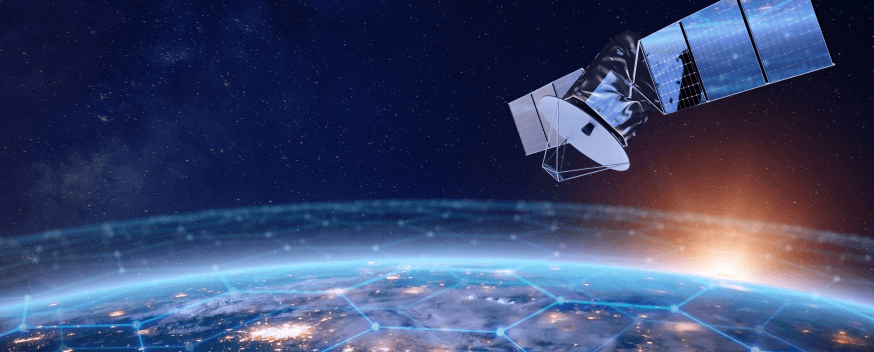Lower your internet bill
61% of people overpay for their internet.
Are you one of them?
Unlock exclusive offers in your area!
Call now
[tel]Enter zip code
Do you live out in the country where there’s plenty of wildlife and scenery, but not so many humans? Maybe you spend seasons in a mountain cabin, in an RV, or on a ranch or farm. In these remote or rural areas, you often won’t find wired internet options like cable internet or fiber internet.
It’s crucial to have a high-speed internet connection now that so many activities in work and education have migrated online. If you’re wondering how to get connected without wired internet options, you’ve come to the right place for answers. For over a decade now, high-speed satellite internet has been a trusted alternative to keep people connected to the digital world.
In this article, we’ll explore the best satellite internet providers of 2025. Here, you’ll find tips on choosing the best provider and optimizing your satellite internet experience. We’ll also give you a quick overview of how satellite internet works, equipment and installation, and the strengths and weaknesses of the three major satellite internet providers.

Satellite internet is a type of internet connection that transmits and receives data as radio signals. Instead of using infrastructure like cables or wires, satellite internet is wireless. Each satellite internet provider owns a network of satellites orbiting high above the earth. The radio signals bounce back and forth between your home on earth, the satellite in space, and a ground station.
Because satellite internet does not require wires or cables, it can reach enormous areas of the world that have no other internet service. Almost every home in the USA can receive satellite internet service. All you need is a clear view of the southern sky from your household or your RV.
While satellite internet has improved significantly over the years, it generally offers lower speeds compared to cable or fiber connections. Your satellite internet connection must reach 25 Mbps download/3 Mbps upload to qualify for the FCC’s definition of high-speed internet[1]. The good news is that satellite internet does reach these speeds, and can offer you solid internet access with the right satellite internet provider
Satellite internet often experiences higher latency compared to wired internet connections. Latency is a tiny lag in an internet transmission caused when a signal has to travel a long distance. This lag is usually too small to be noticeable, but it can negatively affect real-time applications like online gaming or video conferencing.
Even as the federal government and internet service providers build more wired infrastructure, there are many regions where it will never be possible to lay fiber or cable lines. Satellite internet will always be the internet of choice in those areas, as well as for emergencies when infrastructure fails. In addition, satellite internet is a solid choice for people who frequently travel to areas beyond the reach of cell towers

Satellite internet provides a much-needed service to many areas of the country where digital access is sorely needed. The high-speed internet now possible with satellite internet providers can support your digital activities quite well. Because you will often have a choice between all three major satellite internet providers, we’ve compared prices and other plan features to give you some idea of the strengths of each provider.
Viasat stands out as the best provider of high-speed satellite internet. Offering higher speeds than HughesNet, Viasat features a variety of plans to allow you to balance your data needs with your budget. Viasat internet plans can reach the highest speeds of any geostationary satellite internet service. Viasat download speeds go up to 150 Mbps, far faster than HughesNet’s top download speed of 25 Mbps.
Viasat also offers unlimited Standard Data, so you’ll never pay unexpected overage charges. In addition, Viasat’s monthly data allowances for High-Speed Data are much higher than HughesNet’s. If you work from home and need to download large files, these higher data allowances could be a lifesaver. Getting more High-Speed Data will also help users who want to stream a lot of video. And if you experience an unusual data load in one month, Viasat does allow the purchase of additional GB of High-Speed Data at reasonable prices.
Viasat recently launched a new satellite, the ViaSat 3 Americas, which will provide even better speed and bandwidth for Viasat customers [2].
Viasat offers customers the option to rent their satellite equipment instead of buying, if you’d rather pay a lower monthly rental fee than invest $300 up front. One drawback of both Viasat and HughesNet is that you will need to sign a two-year contract, and cancellation before the contract’s end will trigger an early termination fee.
While Viasat takes the top spot, other satellite internet providers can also provide good service under the right circumstances. In general, though, HughesNet loses out to Viasat on both speed and pricing. Starlink, the newest satellite ISP and brainchild of Elon Musk, is significantly more expensive and currently has long waiting lists and supply chain issues.
HughesNet is another prominent player in the satellite internet market. Their internet service offers download speeds up to 25 Mbps. HughesNet does offer a low starting price for its first-tier plan. The problem is that their data allowances are so low. For that introductory price, you will only get 15 GB of high-speed data per month. If you do any video streaming or large file downloads, you’ll go through 15 GB pretty quickly. Then you’ll have to pay for more data, which will start at $9 for an extra 3 GB and go up to $75 for an extra 25 GB.
If you mostly just email and do light web browsing, you may be fine with that first-tier 15 GB plan. But if you have bigger data needs for movies, work, or school, you’ll need a more expensive plan. The largest HughesNet data plan is 200 GB, while Viasat’s largest is 500 GB.
Like Viasat, HughesNet allows customers an equipment rental option for a monthly fee. And HughesNet also requires a two-year contract, so you will pay an early termination fee if you cancel service early.
Starlink, a project by SpaceX, is a newcomer to the satellite internet arena. With its ambitious satellite constellation in low Earth orbit (LEO), Starlink aims to provide high-speed, low-latency internet globally. While Starlink does offer high speeds, the company has very long waiting lists in many areas[3]. Some customers have experienced mystery and frustration about when they will actually receive their orders [4].
Though Starlink’s LEO satellites would offer complete global coverage, the 30,000 satellites required to do so has raised some objections from scientists[5]. Light pollution for astronomy is an issue, and even ordinary skywatchers are sometimes shocked to see a parade of Starlink satellites marching across the sky[6]. It remains to be seen whether Starlink’s technology will fulfill its claims and prevent any falling satellites from causing ground or ocean pollution. The global community has already expressed concern about potential collisions with space junk [7].
Starlink until very recently required the upfront purchase of its equipment for at least $599. It appears the company is now adding a rental option in some select residential markets [8]. Starlink does have the singular advantage among satellite internet providers of not requiring contracts.
Starlink plans are much more expensive than other satellite plans. You will pay $110 per month for Starlink. Theoretically, that price will deliver 50 to 200 Mbps speed, but speeds may be slower depending on locations and networks.
Though the users who have actually managed to receive their equipment and activate service often report satisfaction, Starlink’s biggest issue is its waitlist and lack of demonstrated operational success. Only time will tell if their business model will survive.
Ensure the provider offers coverage in your area without long waiting lists or unpredictable delivery.
Determine the speed requirements for your internet activities, such as streaming or gaming. Understand the realistic capabilities of satellite internet compared to wired infrastructure. Understand what speed your provider will consistently deliver, not just the potential maximum speed.
Assess your monthly data needs to avoid exceeding data caps. Consider whether a provider allows extra data purchases and any other user-friendly data options.
Compare pricing and plans to find the best value for your budget given your data needs.

To be happy with your satellite internet service, you’ll need to know how to use it wisely for the internet activities you like.
Browsing and Email: Satellite internet works well for web browsing and email usage. These activities don’t consume a lot of data. You can stay connected without using up your monthly data allowance.
Streaming: If you enjoy streaming movies or TV shows, choose lower resolution options (SD instead of HD or 4K) to minimize data consumption. Consider downloading content during off-peak hours to avoid peak-time congestion.
Gaming: Satellite internet’s higher latency can impact online gaming experiences. Choose single-player or offline games that don’t rely on real-time, split-second interactions. In addition, console gaming can consume enormous amounts of data. Watch your downloads carefully and schedule them during off hours.
Work and Video Conferencing: Satellite internet can support remote work and video conferencing, but be mindful of latency. Adjust your expectations. Using audio-only calls or pre-downloading large files can help prevent latency-related issues.
By now, you may be wondering why Starlink has launched so many satellites into Low Earth Orbit (LEO) when the other two major providers have chosen fewer satellites in the higher orbit known as GEO.
All satellite internet operates through a network of satellites positioned in space. Geosynchronous equatorial orbit (GEO) satellites remain fixed above a specific point on Earth, providing continuous coverage to a specific region. They are also known as geostationary satellites, and they are 22,000 miles from Earth’s surface. These satellites relay signals between the user’s dish (located on the ground) and the provider’s ground station.
Low Earth Orbit (LEO) satellites orbit the Earth at lower altitudes, offering faster speeds and lower latency. LEO satellite constellations like Starlink’s work together to provide global coverage by handing off data signals between satellites as they move across the sky. That’s why Starlink requires so many satellites.
When installing satellite internet, expect the following steps:
Dish Installation: A technician will mount a dish on your property in a location with a clear view of the sky to get your best signal reception.
Modem Setup: The technician will connect a modem to the dish and configure it to establish an internet connection.
Network Configuration: Once the modem is set up, the technician will configure your network, including Wi-Fi settings and security.
Testing and Activation: The technician will perform tests to ensure your internet connection is working correctly. You’ll also receive information about your plan and any necessary instructions.
Satellite internet primarily caters to rural and remote areas. But you can also get satellite internet in urban areas where wired internet connections may be limited or unreliable.
Satellite internet can support online gaming, but users will need to avoid certain types of games. For online multiplayer games in real time, higher latency may cause noticeable delays. Data demands from downloads for console games may overload your data allowance. Providers recommend that you choose games that don’t rely on real-time interactions.
Weather conditions can temporarily affect satellite internet performance. Rain, snow, or heavy cloud cover can cause signal interference. However, modern satellite systems are designed to avoid these effects.